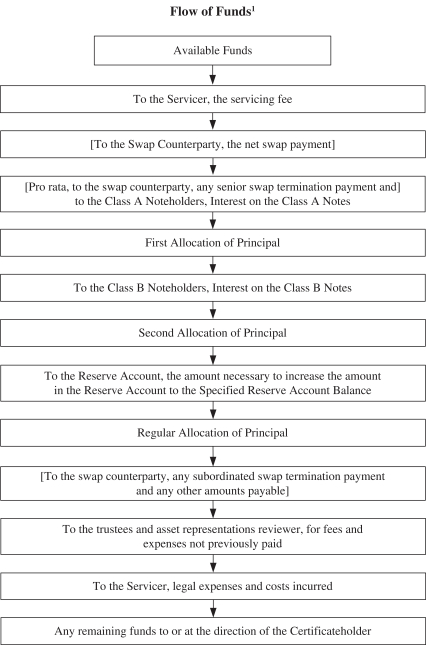The information in this preliminary prospectus is not complete and may be amended. We may not sell the notes described in this preliminary prospectus until we deliver a final prospectus. This preliminary prospectus is not an offer to sell the notes and is not seeking an offer to buy the notes in any state where the offer or sale is not permitted.
Subject to completion, dated [●][●], 20[●][●]
PROSPECTUS
$[●][(1)][(4)]
USAA AUTO OWNER TRUST 20[●]-[●]
Issuing Entity
Central Index Key Number: [ ]
USAA Acceptance, LLC
Depositor
Central Index Key Number: 0001178049

USAA FEDERAL SAVINGS BANK
Sponsor, Seller and Servicer
Central Index Key Number: 0000908392
Before you purchase any of these notes, be sure you read this prospectus, especially the risk factors beginning on page 26 of this prospectus.
A note is not a deposit and neither the notes nor the underlying motor vehicle loans are insured or guaranteed by the FDIC or any other governmental authority.
The notes will represent obligations of the issuing entity only and will not represent obligations of USAA Acceptance, LLC, USAA Federal Savings Bank or any of their respective affiliates.
| [(1) | The aggregate principal amount issued of notes will be either $[ ] or $[ ]. See “Risk Factors—Risks associated with unknown initial principal amount of notes.” If such amount is $[ ], USAA Auto Owner Trust 20[●]-[●] will issue the notes[(4)] described in the table below:] [The following notes are being issued by USAA Auto Owner Trust 20[●]-[●]:] |
| Class A-1 Notes |
Class A-2[-A] Notes[(7)] |
[Class
A-2-B Notes[(7)]] |
Class A-3 Notes[(7)] |
Class A-4 Notes[(7)] |
Class B Notes |
|||||||||||||||||||
| Principal Amount Issued[(2)] |
$ | [ | ●] | $ | [ | ●] | $[●] | $ | [ | ●] | $ | [ | ●] | $ | [ | ●] | ||||||||
| Principal Amount Offered[(3)] |
$ | [ | ●] | $ | [ | ●] | $[●] | $ | [ | ●] | $ | [ | ●] | $ | [ | ●] | ||||||||
| Per Annum Interest Rate(5) |
[ | ●]% | [ | ●]% | [Benchmark]+[●]%[(6)] | [ | ●]% | [ | ●]% | [ | ●]% | |||||||||||||
| Final Scheduled Payment Date |
[ | ●] | [ | ●] | [●] | [ | ●] | [ | ●] | [ | ●] | |||||||||||||
| Initial Public Offering Price |
[ | ●]% | [ | ●]% | [●]% | [ | ●]% | [ | ●]% | [ | ●]% | |||||||||||||
| Underwriting Discount |
[ | ●]% | [ | ●]% | [●]% | [ | ●]% | [ | ●]% | [ | ●]% | |||||||||||||
| Proceeds to Depositor(8) |
[ | ●]% | [ | ●]% | [●]% | [ | ●]% | [ | ●]% | [ | ●]% | |||||||||||||
| [(2) | If the aggregate principal amount issued is $[ ], the trust will issue $[ ] of class A-1 notes, $[ ] of class A-2 notes, $[ ] of class A-3 notes and $[ ] of class A-4 notes[and $[ ] of class B notes.]] |
| [(3) | If the aggregate principal amount issued is $[ ], the initial offered amount will be comprised of $[ ] of class A-1 notes, $[ ] of class A-2 notes, $[ ] of class A-3 notes and $[ ] of class A-4 notes[and $[ ] of class B notes.] |
| (4) | One or more majority-owned affiliates of the Bank will retain [all of the Class [ ] notes and [●]% of the initial principal amount of each [other] class of notes. See “Originator, Sponsor, Seller and Servicer—Credit Risk Retention.” The depositor or one of its affiliates may initially retain an additional amount of all or one or more classes of notes. |
| (5) | The interest rate for each class of notes will be a fixed rate[, a floating rate or a combination of a fixed rate and a floating rate if that class has both a fixed rate tranche and a floating rate tranche]. |
| [(6) | The interest rate on the Class A-2-B Notes will be based on [insert applicable floating rate benchmark]. For a description of how [insert applicable floating rate benchmark] is determined see “Description of the Notes—Payments of Interest.” If the sum of Benchmark + [●]% is less than 0.00% for any interest accrual period, then the interest rate for the Class A-2-B notes for such interest accrual period will be deemed to be 0.00%. For a description of how interest will be calculated on the Class A-2-B notes, see “Description of the Notes—Payments of Interest” in this prospectus.] [NOTE: If floating rate notes are offered, the applicable prospectus will disclose the terms of the specific index, which will be an index other than LIBOR, that will be used to determine interest payments for such floating rate tranches.] |
| [(7) | The aggregate initial principal balance of the Class A-[ ] notes and the Class A-[ ] notes will be $[ ]. The initial principal balance of the Class A-[ ] notes and the Class A-[ ] notes will be determined on or prior to the day of pricing of those classes of notes.] |
| (8) | Before deducting expenses payable by the depositor estimated to be $[●]. |
The total initial public offering price is $[●], the total underwriting discount is $[●] and the total proceeds to the depositor is $[●], in each case calculated based on the offered principal amount of the notes.


